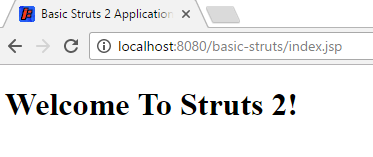如何创建一个Struts 2 Web应用
2018-01-13 21:56
357 查看
翻译自Struts官方文档,原文地址:点击打开链接
本教程将一步一步的教你如何使用Struts2 框架创建一个简单的Web应用。
虽然Struts 2框架使用很简单,但是想要创建一个复杂的Web应用,你最好有J2EE基础知识和技术,包括:
Java
Filters, JSP, and Tag Libraries
JavaBeans
HTML and HTTP
Web Containers (such as Tomcat)
XML
想要学习更多基础技术,请看关键技术入门
接下来,我们将使用Struts 2创建一个Web应用,使用Maven作为依赖管理工具。你可以去Struts 2 GitHub仓库struts-examples 查看或下载所有示例程序。
这个教程假设你已经知道如何创建一个Java web应用,并且会使用Maven管理项目依赖和构建Web应用。这儿有一篇关于如何使用Eclipse创建一个Maven工程的文章。
根据Maven项目标准文件夹结构,在你的Java IDE中创建一个Java Web项目(Maven项目),并命名为basic_struts。在你项目的pom.xml中将包含下面的内容:
pom.xml
添加Jetty maven插件到pom.xml.
pom.xml jetty 插件
上面的插件将使你能够使用
我们下一步将在项目中添加一个简单的index.jsp文件.在src/mian/webapp下创建一个index.jsp文件,并以Basic Struts 2 Application作为标题,在页面中添加一个h1标签,内容为Welcome to Struts 2!。
index.jsp
使用mvn jetty:run 来运行这个项目。
在你的浏览器中输入 http://localhost:8080/basic-struts/index.jsp.你将看到下面的页面:

现在我们已经能够运行这个Java Web项目了,接下来添加Struts 2框架所需的Jar包到项目Class Path中。我们只需在pom.xml中添加一下依赖:
pom.xml 依赖
当然你需要使用当前Struts 2版本去替换掉
Maven将自动下载
从Struts2 2.2.3版本开始,不再需要单独引入javassist依赖。
要想 查看Struts2项目运行的流程,需要添加log4j2日志。在你项目的src/main/resources下创建一个
log4j2.xml
上面的log4j2配置指定控制台作为日志的输出目标。
你需要添加log4j2依赖到pom.xml文件中:
pom.xml log4j 依赖
可以使用log4j-core 和 log4j-api的最新版本,这并不会和Struts 2框架提供的log4依赖冲突。
通常,我们会使用Maven bom在dependencyManagement标签中包含Struts
和 log4j2依赖,像下面那样。这样你就可以在每个使用的依赖模块配置中省略version 这一行的配置,
并且
启用Struts 2 框架需要在web.xml中配置一个Servlet过滤器。下面展示如何在web.xml中配置Struts
2核心过滤器。web.xml文件在src/main/webapp/WEB-INF下:
web.xml Servlet Filter
获取更多关于Struts 2部署描述符的信息,请看Core Developers Guide / web.xml page. 注意,url-pattern节点值为
2过滤器将拦截这个应用所有的请求。
Struts 2 不仅可以使用XML 配置还可以使用注解配置(或者两者混合使用)来表示URL、Java类和视图页面(例如index.jsp)之间的关系。对于基础Struts2 的应用,我们将采用最小化配置。 注意:这个文件的文件名是
path下,也就是WEB-INF/classes路径下。默认的Maven在打包部署的时候会将src/main/resources下的资源文件拷贝到WEB-INF/classes下).
struts.xml
使用jetty Maven插件(打开终端,进入到项目目录下)运行
在控制台将会看到很多的调试信息,意思是告诉你Struts 2框架已经被包含在basic-struts2 web应用中了。
打开浏览器输入 http://localhost:8080/basic-struts/index.action (注意:URL结尾是
你将看到和访问 http://localhost:8080/basic-struts/index.jsp.一样的页面。 查看控制台输出,你应该可以看到关于
Struts 2 日志信息
如果你在使用教程的示例程序时遇到问题,你可以去Struts 2 用户问题讨论区 找答案,如果在这没有找到你需要的答案,你可以在这里发布你的问题。
本教程将一步一步的教你如何使用Struts2 框架创建一个简单的Web应用。
虽然Struts 2框架使用很简单,但是想要创建一个复杂的Web应用,你最好有J2EE基础知识和技术,包括:
Java
Filters, JSP, and Tag Libraries
JavaBeans
HTML and HTTP
Web Containers (such as Tomcat)
XML
想要学习更多基础技术,请看关键技术入门
Java相关环境要求
Servlet API 2.4+, JSP 2.0+ , Java 7+.
我们的第一个Struts Web应用
接下来,我们将使用Struts 2创建一个Web应用,使用Maven作为依赖管理工具。你可以去Struts 2 GitHub仓库struts-examples 查看或下载所有示例程序。
创建一个Struts 2 Web应用,使用Maven管理依赖和构建这个项目。
这个教程假设你已经知道如何创建一个Java web应用,并且会使用Maven管理项目依赖和构建Web应用。这儿有一篇关于如何使用Eclipse创建一个Maven工程的文章。
步骤 1 - 创建一个Java Web项目
根据Maven项目标准文件夹结构,在你的Java IDE中创建一个Java Web项目(Maven项目),并命名为basic_struts。在你项目的pom.xml中将包含下面的内容:
pom.xml
<build> <finalName>basic-struts</finalName> </build>
添加Jetty maven插件到pom.xml.
pom.xml jetty 插件
<build>
...
<plugins>
<plugin>
<groupId>org.eclipse.jetty</groupId>
<artifactId>jetty-maven-plugin</artifactId>
<version>9.4.7.v20170914</version>
<configuration>
<webApp>
<contextPath>/${build.finalName}</contextPath>
</webApp>
<stopKey>CTRL+C</stopKey>
<stopPort>8999</stopPort>
<scanIntervalSeconds>10</scanIntervalSeconds>
<scanTargets>
<scanTarget>src/main/webapp/WEB-INF/web.xml</scanTarget>
</scanTargets>
</configuration>
</plugin>
</plugins>
</build>上面的插件将使你能够使用
mvn jetty:run 命令来运行你的项目。
步骤2 - 添加 index.jsp
我们下一步将在项目中添加一个简单的index.jsp文件.在src/mian/webapp下创建一个index.jsp文件,并以Basic Struts 2 Application作为标题,在页面中添加一个h1标签,内容为Welcome to Struts 2!。index.jsp
<!DOCTYPE html> <%@ page language="java" contentType="text/html; charset=UTF-8" pageEncoding="UTF-8" %> <html> <head> <meta charset="UTF-8"> <title>Basic Struts 2 Application - Welcome</title> </head> <body> <h1>Welcome To Struts 2!</h1> </body> </html>
使用mvn jetty:run 来运行这个项目。
在你的浏览器中输入 http://localhost:8080/basic-struts/index.jsp.你将看到下面的页面:

步骤 3 - 添加 Struts 2 Jar 包 到 Class Path
现在我们已经能够运行这个Java Web项目了,接下来添加Struts 2框架所需的Jar包到项目Class Path中。我们只需在pom.xml中添加一下依赖:pom.xml 依赖
<dependency>
<groupId>org.apache.struts</groupId>
<artifactId>struts2-core</artifactId>
<version>${struts2.version}</version>
</dependency>当然你需要使用当前Struts 2版本去替换掉
${struts2.version} (或者在pom中 定义一个 properties).
Maven将自动下载
struts2-corejar包 和其依赖包 (传递性依赖).
从Struts2 2.2.3版本开始,不再需要单独引入javassist依赖。
步骤 4 - 添加 日志
要想 查看Struts2项目运行的流程,需要添加log4j2日志。在你项目的src/main/resources下创建一个log4j2.xml文件,按照下面的内容去配置log4j2:
log4j2.xml
<?xml version="1.0" encoding="UTF-8"?>
<Configuration>
<Appenders>
<Console name="STDOUT" target="SYSTEM_OUT">
<PatternLayout pattern="%d %-5p [%t] %C{2} (%F:%L) - %m%n"/>
</Console>
</Appenders>
<Loggers>
<Logger name="com.opensymphony.xwork2" level="debug"/>
<Logger name="org.apache.struts2" level="debug"/>
<Root level="warn">
<AppenderRef ref="STDOUT"/>
</Root>
</Loggers>
</Configuration>上面的log4j2配置指定控制台作为日志的输出目标。
你需要添加log4j2依赖到pom.xml文件中:
pom.xml log4j 依赖
<dependency>
<groupId>org.apache.logging.log4j</groupId>
<artifactId>log4j-core</artifactId>
<version>${log4j2.version}</version>
</dependency>
<dependency>
<groupId>org.apache.logging.log4j</groupId>
<artifactId>log4j-api</artifactId>
<version>${log4j2.version}</version>
</dependency>可以使用log4j-core 和 log4j-api的最新版本,这并不会和Struts 2框架提供的log4依赖冲突。
通常,我们会使用Maven bom在dependencyManagement标签中包含Struts
和 log4j2依赖,像下面那样。这样你就可以在每个使用的依赖模块配置中省略version 这一行的配置,
并且
struts2-*和
log4j-*所有的模块都能够使用一致的版本。
struts2-bom从2.3.20版本开始可以使用.
<properties>
<project.build.sourceEncoding>UTF-8</project.build.sourceEncoding>
<project.reporting.outputEncoding>UTF-8</project.reporting.outputEncoding>
<java.version>1.8</java.version>
<struts2.version>2.5.14.1</struts2.version>
<log4j2.version>2.10.0</log4j2.version>
</properties>
<dependencyManagement>
<dependencies>
<dependency>
<groupId>org.apache.struts</groupId>
<artifactId>struts2-bom</artifactId>
<version>${struts2.version}</version>
<type>pom</type>
<scope>import</scope>
</dependency>
<dependency>
<groupId>org.apache.logging.log4j</groupId>
<artifactId>log4j-bom</artifactId>
<version>${log4j2.version}</version>
<scope>import</scope>
<type>pom</type>
</dependency>
</dependencies>
</dependencyManagement>
<dependencies>
<!-- Struts 2 -->
<dependency>
<groupId>org.apache.struts</groupId>
<artifactId>struts2-core</artifactId>
</dependency>
<dependency>
<groupId>org.apache.logging.log4j</groupId>
<artifactId>log4j-core</artifactId>
</dependency>
</dependencies>
步骤 5 - 添加 Struts 2 Servlet 过滤器
启用Struts 2 框架需要在web.xml中配置一个Servlet过滤器。下面展示如何在web.xml中配置Struts2核心过滤器。web.xml文件在src/main/webapp/WEB-INF下:
web.xml Servlet Filter
<?xml version="1.0" encoding="UTF-8"?> <web-app id="WebApp_ID" version="2.4" xmlns="http://java.sun.com/xml/ns/j2ee" xmlns:xsi="http://www.w3.org/2001/XMLSchema-instance" xsi:schemaLocation="http://java.sun.com/xml/ns/j2ee http://java.sun.com/xml/ns/j2ee/web-app_2_4.xsd"> <display-name>Basic Struts2</display-name> <welcome-file-list> <welcome-file>index</welcome-file> </welcome-file-list> <filter> <filter-name>struts2</filter-name> <filter-class>org.apache.struts2.dispatcher.filter.StrutsPrepareAndExecuteFilter</filter-class> </filter> <filter-mapping> <filter-name>struts2</filter-name> <url-pattern>/*</url-pattern> </filter-mapping> </web-app>
获取更多关于Struts 2部署描述符的信息,请看Core Developers Guide / web.xml page. 注意,url-pattern节点值为
/*这意味着Struts
2过滤器将拦截这个应用所有的请求。
步骤 6 - 创建 struts.xml
Struts 2 不仅可以使用XML 配置还可以使用注解配置(或者两者混合使用)来表示URL、Java类和视图页面(例如index.jsp)之间的关系。对于基础Struts2 的应用,我们将采用最小化配置。 注意:这个文件的文件名是 struts.xml并且它应该放在
src/main/resources文件夹下(
struts.xml文件必须放在web应用的根class
path下,也就是WEB-INF/classes路径下。默认的Maven在打包部署的时候会将src/main/resources下的资源文件拷贝到WEB-INF/classes下).
struts.xml
<?xml version="1.0" encoding="UTF-8"?> <!DOCTYPE struts PUBLIC "-//Apache Software Foundation//DTD Struts Configuration 2.5//EN" "http://struts.apache.org/dtds/struts-2.5.dtd"> <struts> <constant name="struts.devMode" value="true" /> <package name="basicstruts2" extends="struts-default"> <action name="index"> <result>/index.jsp</result> </action> </package> </struts>这个配置文件告诉Struts 2框架,当请求的URL以index.action结尾时,将会使浏览器重定向到
index.jsp.
步骤 7 - 构建并运行应用
使用jetty Maven插件(打开终端,进入到项目目录下)运行mvn jetty:run命令,去运行这个web应用。
在控制台将会看到很多的调试信息,意思是告诉你Struts 2框架已经被包含在basic-struts2 web应用中了。
打开浏览器输入 http://localhost:8080/basic-struts/index.action (注意:URL结尾是
index.action不是
index.jsp).
你将看到和访问 http://localhost:8080/basic-struts/index.jsp.一样的页面。 查看控制台输出,你应该可以看到关于
index.actionand
index.jsp的消息。
Struts 2 日志信息
... 2017-04-17 11:16:01,084 DEBUG [qtp1723848804-22] xwork2.DefaultActionProxy (DefaultActionProxy.java:89) - Creating an DefaultActionProxy for namespace [/] and action name [index] ... 2017-04-17 11:16:01,172 DEBUG [qtp1723848804-22] result.ServletDispatcherResult (ServletDispatcherResult.java:131) - Forwarding to location: /index.jsp ...
获取帮助
如果你在使用教程的示例程序时遇到问题,你可以去Struts 2 用户问题讨论区 找答案,如果在这没有找到你需要的答案,你可以在这里发布你的问题。| 上一篇Struts 2快速入门 | or | 下一篇 Struts 2 Hello World |
相关文章推荐
- 创建一个基于Struts 2的Web应用
- 你对MVC的理解,MVC有什么优缺点?结合Struts,说明在一个Web应用如何去使用?
- 如何创建一个iPhone Web应用
- 你对MVC的理解,MVC有什么优缺点?结合Struts,说明在一个Web应用如何去使用?
- Linux有问必答:如何在命令行创建一个MySQL数据库
- MOSS 2007应用日记(12)――如何创建一个会议工作区
- 如何创建一个可以保存13亿数据的数组?兼谈时间和空间之间永无休止的战争
- 01. 如何创建一个canvas并画一条线段
- VB6 如何创建一个标准控制台程序
- 【LINUX】——linux如何使用Python创建一个web服务
- 如何创建一个GUID
- 一个关于eclipse中如何快速创建构造方法
- Maven 3 入门 -- 如何创建一个web应用程序
- 不使用循环,如何创建一个长度为100的数组,并且数组的每一个元素是该元素的下标?
- android 如何创建一个模拟接口
- 如何创建一个简单的C++同步锁框架(译)
- 如何给你的AIR应用创建一个启动屏幕
- 如何创建一个Team Project
- Linux如何创建一个进程?
- Cocos2D iOS之旅:如何写一个敲地鼠游戏(十):创建游戏逻辑
